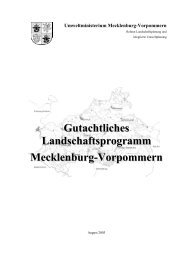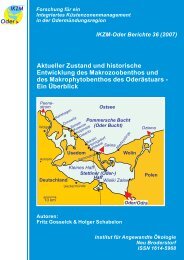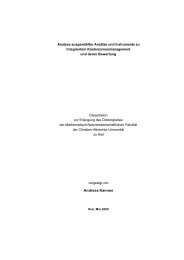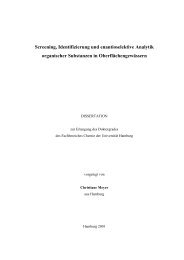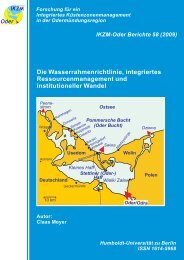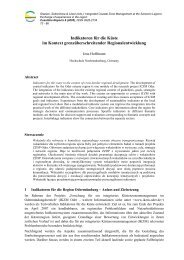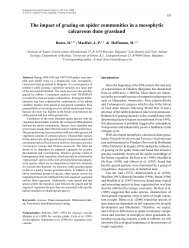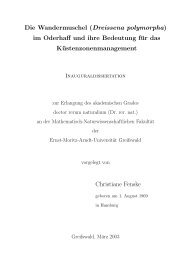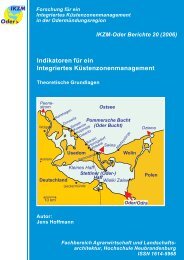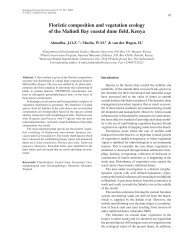The harbour of ancient Krane, Kutavos Bay (Cefalonia, Greece) – an ...
The harbour of ancient Krane, Kutavos Bay (Cefalonia, Greece) – an ...
The harbour of ancient Krane, Kutavos Bay (Cefalonia, Greece) – an ...
Create successful ePaper yourself
Turn your PDF publications into a flip-book with our unique Google optimized e-Paper software.
Karius, Hadler, Deicke, von Eynatten, Brückner & Vött (eds.):<br />
Dynamische Küsten <strong>–</strong> Prozesse, Zusammenhänge und Auswirkungen<br />
Coastline Reports 17 (2011), ISSN 0928-2734, ISBN 978-3-939206-00-2<br />
S. 111 - 122<br />
<strong>The</strong> <strong>harbour</strong> <strong>of</strong> <strong><strong>an</strong>cient</strong> <strong>Kr<strong>an</strong>e</strong>, <strong>Kutavos</strong> <strong>Bay</strong> (<strong>Cefalonia</strong>, <strong>Greece</strong>) <strong>–</strong><br />
<strong>an</strong> excellent geo-archive for palaeo-tsunami research<br />
H<strong>an</strong>na Hadler 1 , Andreas Vött 1 , Helmut Brückner 2 , Georg Bareth 2 , Konst<strong>an</strong>tin Ntageretzis 1 ,<br />
Heinz Warnecke 3 & Timo Willershäuser 1<br />
Abstract<br />
1 Institute for Geography, Joh<strong>an</strong>nes Gutenberg-Universität<br />
2 Institute for Geography, Universität zu Köln<br />
3 In der Mulde 10, D-51503 Rösrath-Forsbach, Germ<strong>an</strong>y<br />
Associated to palaeo-tsunami research conducted within the framework <strong>of</strong> <strong>an</strong> interdisciplinary<br />
project on tsunami impacts along the coasts <strong>of</strong> the eastern Ioni<strong>an</strong> Sea, tsunami traces were sought<br />
for in the <strong>harbour</strong> <strong>of</strong> the <strong><strong>an</strong>cient</strong> city <strong>of</strong> <strong>Kr<strong>an</strong>e</strong> (<strong>Cefalonia</strong>, Ioni<strong>an</strong> Isl<strong>an</strong>ds, <strong>Greece</strong>). <strong>The</strong> <strong>harbour</strong> is<br />
located in the inner <strong>Bay</strong> <strong>of</strong> Argostoli, the so called <strong>Kutavos</strong> <strong>Bay</strong>. With a maximum depth <strong>of</strong> 1 m<br />
the bay represents a shallow lagoonal to marine, quiescent water environment. Geo-scientific<br />
studies comprised near-shore vibracoring <strong>an</strong>d sedimentological as well as geochemical <strong>an</strong>alyses <strong>of</strong><br />
recovered sediments.<br />
Autochthonous lagoonal <strong>an</strong>d back beach swamp deposits were found intersected by layers <strong>of</strong><br />
allochthonous gravel <strong>an</strong>d intensely reworked lagoonal sediments. Due to the sheltered position <strong>of</strong><br />
the inner <strong>Kutavos</strong> <strong>Bay</strong> <strong>an</strong>d the shallow-water conditions, storm influence c<strong>an</strong> be excluded as<br />
triggering factor for the temporary interference <strong>of</strong> the local stratigraphical record. High-energy<br />
coarse-grained intersecting layers thus represent clear tsunami fingerprints. Tsunami l<strong>an</strong>dfall in the<br />
inner <strong>Kutavos</strong> <strong>Bay</strong> seems to be strongly related to tsunami wave refraction <strong>an</strong>d diffraction at Cape<br />
<strong>The</strong>odorou/Argostoli, lying 5 km towards the northwest, <strong>an</strong>d reflection in the <strong>Bay</strong> <strong>of</strong> Livadi, lying<br />
14 km to the north. Compared to the results <strong>of</strong> palaeo-tsunami studies that were conducted in the<br />
Livadi coastal plain <strong>an</strong>d in the Lixouri coastal lowl<strong>an</strong>ds (Gulf <strong>of</strong> Argostoli, Willershäuser et al.,<br />
this issue) it seems as if the bays <strong>of</strong> Livadi <strong>an</strong>d <strong>Kutavos</strong> were hit by the same events.<br />
<strong>The</strong> <strong>harbour</strong> <strong>of</strong> <strong><strong>an</strong>cient</strong> <strong>Kr<strong>an</strong>e</strong> represents a highly valuable tsunami sediment trap with <strong>an</strong> excellent<br />
potential for further investigations.<br />
1 Introduction<br />
Located in the Ioni<strong>an</strong> Sea, the isl<strong>an</strong>d <strong>of</strong> <strong>Cefalonia</strong> is directly exposed to the northern part <strong>of</strong> the<br />
Hellenic Arc, lying to the south <strong>of</strong> the isl<strong>an</strong>d (figure 1). Along this plate boundary the predomin<strong>an</strong>t<br />
geotectonic dynamic is described by the Afric<strong>an</strong> plate being subducted under the Aege<strong>an</strong> microplate.<br />
Passing the isl<strong>an</strong>d to the north-west, however, the <strong>Cefalonia</strong> tr<strong>an</strong>sform fault (CF) links the highly<br />
active subduction zone to a zone <strong>of</strong> continental collision further north. <strong>Cefalonia</strong> is situated in one <strong>of</strong><br />
the seismically most active regions in the eastern Mediterr<strong>an</strong>e<strong>an</strong> (Pirazzoli et al. 1994, Louvari et al.<br />
1999, Papadopoulos et al. 2007, Tselentis et al. 2010).<br />
Strong earthquakes are particularly frequent throughout the Ioni<strong>an</strong> Sea as well as the entire eastern<br />
Mediterr<strong>an</strong>e<strong>an</strong> Sea. Near <strong>Cefalonia</strong>, three earthquakes with magnitudes <strong>of</strong> M > 7 occurred during the<br />
past decades causing major destruction. Commonly inducing vertical <strong>of</strong>fsets <strong>of</strong> the sea floor <strong>an</strong>d/or<br />
submarine slides (Cocard et al. 1999, Hollenstein 2006, 2008), these earthquakes hold a high potential<br />
for generating tsunamis. Soloviev (1990) <strong>an</strong>d Papazachos & Dimitriu (1991) classify the Ioni<strong>an</strong> Sea as<br />
a tsunamigenic zone which is highly capable <strong>of</strong> triggering future tsunamis.
112 Hadler et al.<br />
Figure 1: Tectonic overview <strong>of</strong> <strong>Greece</strong>. (a) Local fault systems <strong>of</strong> <strong>Cefalonia</strong>. Arrows indicate direction <strong>of</strong><br />
thrust. AEF <strong>–</strong> Ayia Ephernia Thrust, AF <strong>–</strong> Argostoli Fault, AT <strong>–</strong> Ainos Thrust, GAT <strong>–</strong> Gulf <strong>of</strong><br />
Argostoli Thrust, IT <strong>–</strong> Ioni<strong>an</strong> Thrust, KAF <strong>–</strong> Kalon Anticline Fault, LT <strong>–</strong> Livadi thrust, OPT Offshore<br />
Poros Thrust. Map modified after Stiros et al. (1994). (b) Tectonic situation <strong>of</strong> <strong>Greece</strong> with main plate<br />
boundaries <strong>an</strong>d faults. Map modified after Doutsos & Kokkalas (2001), Haslinger et al. (1999). (c)<br />
Tsunamigenic zones in the eastern Mediterr<strong>an</strong>e<strong>an</strong> after Papazachos & Dimitriu (1991). K0 represents<br />
the (estimated) maximum tsunami intensity (Sieberg-Ambrasey scale), size <strong>of</strong> ovals reflects intensity<br />
estimates.<br />
Although there are numerous historical accounts on tsunami events in the Mediterr<strong>an</strong>e<strong>an</strong> Sea <strong>an</strong>d<br />
especially in <strong>Greece</strong> (e.g. Antonopoulos 1979, Ambraseys & Synolakis 2010), there is only scarce<br />
information about tsunami impact on <strong>Cefalonia</strong>. For the purpose <strong>of</strong> deciphering <strong>an</strong>d distinguishing<br />
imprints <strong>of</strong> palaeo-tsunamis, one <strong>of</strong> the primary tasks <strong>of</strong> our study was to detect a suitable near-coast<br />
geological archive which acts as a sediment trap for tsunami deposits. Concerning the isl<strong>an</strong>d <strong>of</strong><br />
<strong>Cefalonia</strong>, two coastal areas, the <strong>Bay</strong> <strong>of</strong> Livadi (Willershäuser et al., this issue) <strong>an</strong>d the <strong>Bay</strong> <strong>of</strong><br />
<strong>Kutavos</strong> (figure 2), represent promising geo-archives. Within a regional context, a large variety <strong>of</strong><br />
different tsunami traces have already been detected in the nearby Lefkada-Preveza coastal zone <strong>an</strong>d<br />
helped to reconstruct multiple tsunami l<strong>an</strong>dfall <strong>an</strong>d its consequences (Vött et al. 2006, 2008, 2009a,<br />
2009b, 2010a, 2010b, May 2010). In general, palaeo-tsunami research based on geo-scientific studies<br />
may also contribute to estimate recurrence intervals for large tsunami events.<br />
2 Location<br />
<strong>The</strong> isl<strong>an</strong>d <strong>of</strong> <strong>Cefalonia</strong> is divided by the Gulf <strong>of</strong> Argostoli into the eastern mainl<strong>an</strong>d <strong>an</strong>d the western<br />
Paliki Peninsula (figure 2, inset map). Opening towards the Ioni<strong>an</strong> Sea in the south, the gulf extends<br />
northwards for approximately 13 km.
<strong>The</strong> <strong>harbour</strong> <strong>of</strong> <strong><strong>an</strong>cient</strong> <strong>Kr<strong>an</strong>e</strong>, <strong>Kutavos</strong> <strong>Bay</strong> (<strong>Cefalonia</strong>, <strong>Greece</strong>) 113<br />
Figure 2: (a) Topographical overview <strong>of</strong> the study area. Map based on Google Earth images (images taken in<br />
2005), modified after Partsch (1889) & Topographic Map 1:75.000 Cephalonia/Ithaka. Inset map<br />
modified after Stiros et al. (1994). Description <strong>of</strong> photos: (b) Overview <strong>of</strong> <strong><strong>an</strong>cient</strong> <strong>Kr<strong>an</strong>e</strong>, the adjacent<br />
coastal plain <strong>an</strong>d <strong>Kutavos</strong> <strong>Bay</strong>. (c) Remains <strong>of</strong> fortification walls <strong>of</strong> <strong>Kr<strong>an</strong>e</strong>. (d) Detailed view <strong>of</strong><br />
hexagonal city wall.<br />
Close to the entr<strong>an</strong>ce <strong>of</strong> the Gulf <strong>of</strong> Argostoli the cul-de-sac-type <strong>Bay</strong> <strong>of</strong> Argostoli with the <strong>Kutavos</strong> at<br />
its very end br<strong>an</strong>ches <strong>of</strong>f from the main gulf extending approximately 5 km to the southeast (figure 3).<br />
<strong>Kutavos</strong> <strong>Bay</strong> (figure 2) is surrounded by the Tilegrafos hills <strong>an</strong>d the city <strong>of</strong> Argostoli to the west, the<br />
coastal plain <strong>of</strong> <strong>Kr<strong>an</strong>e</strong> to the south <strong>an</strong>d the foothill <strong>of</strong> the Aenos mountain r<strong>an</strong>ge to the east. Thus, the<br />
bay is enclosed from direct influences <strong>of</strong> the open Ioni<strong>an</strong> Sea <strong>an</strong>d well protected from storm influence.<br />
<strong>The</strong> small nose-type promontory <strong>of</strong> Drap<strong>an</strong>o on the northeastern shoreline narrows the entr<strong>an</strong>ce <strong>of</strong> the<br />
bay to 0.5 km, contributing to <strong>an</strong> even more sheltered environment. Since 1812 a bridge between<br />
Argostoli <strong>an</strong>d the promontory cuts <strong>Kutavos</strong> <strong>Bay</strong> <strong>of</strong>f, thus enh<strong>an</strong>cing the lagoonal character <strong>of</strong> the inner<br />
bay by further restriction <strong>of</strong> water exch<strong>an</strong>ge dynamics.<br />
<strong>The</strong> study area also comprises the coastal plain <strong>of</strong> <strong>Kr<strong>an</strong>e</strong>, extending towards the southeast in direct<br />
prolongation <strong>of</strong> the bay. Today drained <strong>an</strong>d partly filled with building rubble from the 1953<br />
earthquake, the proximal part <strong>of</strong> the coastal plain was former characterised by a wide back beach<br />
swamp. It is named after the city <strong>of</strong> <strong>Kr<strong>an</strong>e</strong>, one <strong>of</strong> four <strong><strong>an</strong>cient</strong> cities on <strong>Cefalonia</strong>. Inhabited since the<br />
5 th century BC, large parts <strong>of</strong> the city were ab<strong>an</strong>doned in the late 4 th century BC for unknown reasons.<br />
Today only remains <strong>of</strong> fortification walls are visible, overlooking the <strong>Kr<strong>an</strong>e</strong> coastal plain (R<strong>an</strong>dsborg<br />
2002).<br />
<strong>Kutavos</strong> <strong>Bay</strong> represents the natural <strong>harbour</strong> basin <strong>of</strong> <strong><strong>an</strong>cient</strong> <strong>Kr<strong>an</strong>e</strong>; however, the exact location <strong>of</strong> the<br />
<strong><strong>an</strong>cient</strong> <strong>harbour</strong> facilities is still unknown. City walls running from the former Acropolis to the coastal<br />
plain (figure 2) though led to the assumption <strong>of</strong> <strong>an</strong> artificial <strong>harbour</strong> basin close to the recent shoreline.<br />
Ancient lashing rings <strong>an</strong>d other installations found in the coastal plain seem to support this assumption<br />
(Beeskow 1860, Partsch 1889).
114 Hadler et al.<br />
3 Tsunami impact on <strong>Cefalonia</strong> <strong>–</strong> a scenario for <strong>Kutavos</strong> <strong>Bay</strong><br />
As shown above, the Ioni<strong>an</strong> Isl<strong>an</strong>ds are directly exposed to the northern part <strong>of</strong> the Hellenic Arc. A<br />
large tsunami triggered at this section <strong>of</strong> the subduction zone is supposed to reach <strong>an</strong>d affect the<br />
southern coast <strong>of</strong> <strong>Cefalonia</strong> (figure 3 overview). Due to rapidly decreasing water depths <strong>an</strong>d the<br />
funnel-like shape <strong>of</strong> the Gulf <strong>of</strong> Argostoli (figure 3a), it c<strong>an</strong> be expected that tsunami wave heights<br />
increase during their passage across the gulf. Reaching Cape <strong>The</strong>odorou, wave divergence <strong>an</strong>d<br />
diffraction will lead the tsunami into opposite directions (figure 3b), with one wave front entering the<br />
<strong>Bay</strong> <strong>of</strong> Argostoli. Decreasing water depths <strong>an</strong>d narrowing <strong>of</strong> the bay towards the promontory <strong>of</strong><br />
Drap<strong>an</strong>o will additionally increase tsunami wave height. Thus, after passing the headl<strong>an</strong>d <strong>an</strong>d<br />
propagating through <strong>Kutavos</strong> <strong>Bay</strong>, the tsunami will inundate the low-lying coastal plain <strong>of</strong> <strong>Kr<strong>an</strong>e</strong><br />
(figure 3c-1).<br />
Me<strong>an</strong>while, the main wave front will travel northward <strong>an</strong>d inundate the <strong>Bay</strong> <strong>of</strong> Livadi (figure 3c-2)<br />
(see Willershäuser et al., this issue). <strong>The</strong> surrounding hill slopes <strong>of</strong> the Gulf <strong>of</strong> Argostoli will prevent<br />
the wave front from further propagation, so that reflection <strong>of</strong> the wave back towards a southern<br />
direction must be expected. Located opposite to Livadi <strong>an</strong>d opening towards the northwest, the <strong>Bay</strong> <strong>of</strong><br />
Argostoli will have a funnel-like effect on parts <strong>of</strong> the reflected waves causing <strong>an</strong>other inundation <strong>of</strong><br />
the <strong>Kr<strong>an</strong>e</strong> coastal plain. Considering potential reson<strong>an</strong>ce effects, this second phase <strong>of</strong> inundation might<br />
be even stronger th<strong>an</strong> the first.<br />
Figure 3: Simplified tsunami-scenario for the Gulf <strong>of</strong> Argostoli <strong>an</strong>d <strong>Kutavos</strong> <strong>Bay</strong> <strong>an</strong>d overview map <strong>of</strong> <strong>Greece</strong><br />
showing schematic propagation <strong>of</strong> a fictitious tsunami triggered at the Hellenic arc. Black dots<br />
depicted in the upper left inset mapshow epicentres <strong>of</strong> known tsunamigenic earthquakes after<br />
Soloviev (1990). (a) Tsunami wave entering the Gulf <strong>of</strong> Argostoli. (b) Wave divergence <strong>an</strong>d<br />
diffraction at Cape <strong>The</strong>odorou. (c-1) Tsunami l<strong>an</strong>dfall in <strong>Kutavos</strong> <strong>Bay</strong> <strong>an</strong>d inundation <strong>of</strong> the <strong>Kr<strong>an</strong>e</strong><br />
coastal plain. (c-2) Tsunami l<strong>an</strong>dfall in the <strong>Bay</strong> <strong>of</strong> Livadi <strong>an</strong>d reflection <strong>of</strong> wave front. Reflection <strong>an</strong>d<br />
reson<strong>an</strong>ce effects will add up to c-1. Map based on Google Earth images (2009).
<strong>The</strong> <strong>harbour</strong> <strong>of</strong> <strong><strong>an</strong>cient</strong> <strong>Kr<strong>an</strong>e</strong>, <strong>Kutavos</strong> <strong>Bay</strong> (<strong>Cefalonia</strong>, <strong>Greece</strong>) 115<br />
This simplified scenario shows that a strong tsunami may strongly affect the bays <strong>of</strong> Argostoli <strong>an</strong>d<br />
<strong>Kutavos</strong>. <strong>The</strong> concentration <strong>of</strong> tsunami energy in the shallow water environment will lead to intense<br />
interaction between tsunami, sea floor <strong>an</strong>d littoral as well as near-shore terrestrial sediments<br />
(Sugawara et al. 2008). Based on this scenario, the study area represents a promising geo-archive for<br />
palaeo-tsunami research.<br />
4 Methods<br />
Geo-scientific studies on the southeastern shore <strong>of</strong> <strong>Kutavos</strong> <strong>Bay</strong> comprised vibracoring using <strong>an</strong> Atlas<br />
Copco Cobra mk 1 coring device with a core diameter <strong>of</strong> 6 cm <strong>an</strong>d a maximum recovery depth <strong>of</strong> 5 m<br />
below surface (m b.s.). Photo-documentation, description <strong>an</strong>d sampling <strong>of</strong> the retrieved cores were<br />
carried out in the field. Core description comprised the <strong>an</strong>alyses <strong>of</strong> grain size, sediment colour,<br />
calcium carbonate content <strong>an</strong>d noticeable features such as pl<strong>an</strong>t <strong>an</strong>d macr<strong>of</strong>aunal remains or ceramic<br />
fragments (Ad-hoc-Arbeitsgruppe Boden 2005). Position <strong>an</strong>d elevation <strong>of</strong> the coring site <strong>an</strong>d<br />
supplementary DGPS measurements were taken by me<strong>an</strong>s <strong>of</strong> a TOPCON HiperPro FC-200 device.<br />
In the laboratory, geochemical <strong>an</strong>alyses were carried out for st<strong>an</strong>dard parameters such as pH-value,<br />
electrical conductivity, loss on ignition <strong>an</strong>d contents <strong>of</strong> calcium carbonate, (earth) alkaline <strong>an</strong>d heavy<br />
metals. Further laboratory research included x-ray fluorescence measurements (XRF) using a h<strong>an</strong>dheld<br />
XRF-<strong>an</strong>alyser (type <strong>The</strong>rmo Niton XL3t 900s, calibration mode SOIL).<br />
5 Results<br />
<strong>The</strong> geomorphological <strong>an</strong>d geodynamical characteristics <strong>of</strong> near-coast sedimentary environments as<br />
well as the distinct sedimentary <strong>an</strong>d geochemical attributes must be understood in order to detect<br />
unusual <strong>an</strong>d temporary interferences <strong>of</strong> the prevailing autochthonous environmental conditions.<br />
Environmental characteristics <strong>of</strong> the <strong>Kutavos</strong> <strong>Bay</strong><br />
<strong>Kutavos</strong> <strong>Bay</strong> is characterised by low-energy geomorphological <strong>an</strong>d geodynamical processes. As a<br />
result <strong>of</strong> its sheltered position, the inner bay is almost completely cut <strong>of</strong>f from outside influences <strong>of</strong> the<br />
Ioni<strong>an</strong> Sea such as strong oce<strong>an</strong> currents or storm wave activity. With average water depths <strong>of</strong> less<br />
th<strong>an</strong> one meter, the formation <strong>of</strong> large storm-induced waves is additionally limited by the local<br />
geomorphological conditions throughout <strong>Kutavos</strong> <strong>Bay</strong>. Exposure <strong>an</strong>d bathymetry <strong>of</strong> the bay create <strong>an</strong><br />
overall quiescent <strong>an</strong>d shallow still water environment <strong>The</strong> overall local wave climate <strong>of</strong> the inner<br />
<strong>Kutavos</strong> <strong>Bay</strong> thus has to be considered as weak.<br />
Due to prevailing low-energy conditions, the sedimentation processes dominating the <strong>Kutavos</strong> <strong>Bay</strong><br />
geo-archive are those <strong>of</strong> lagoonal or even limnic quiescent water environments. Without strong<br />
currents, sediment supply from marine sources will only comprise small grain sizes such as silt <strong>an</strong>d<br />
clay. <strong>The</strong> sediment input from terrestrial sources is also limited. As for most parts <strong>of</strong> <strong>Cefalonia</strong>,<br />
bedrock units consist <strong>of</strong> Cretaceous limestone <strong>an</strong>d dolomite as well as <strong>of</strong> Pleistocene limestone,<br />
s<strong>an</strong>dstone <strong>an</strong>d conglomerate (IGME 1985). Consequently, the overall hydrological regime is<br />
determined by karst phenomena. <strong>The</strong>re are only a few rivers or streams on the isl<strong>an</strong>d, none to be found<br />
in the coastal plain <strong>of</strong> <strong>Kr<strong>an</strong>e</strong>. Sediment tr<strong>an</strong>sport into <strong>Kutavos</strong> <strong>Bay</strong> is thus limited to torrential surface<br />
run-<strong>of</strong>f during strong precipitation events. Considering the large dimensions <strong>an</strong>d the low gradient <strong>of</strong><br />
the <strong>Kr<strong>an</strong>e</strong> coastal plain, the grain size spectrum tr<strong>an</strong>sported to the shore by fluvial processes is<br />
supposed to comprise fine-grained sediments. Coarser grain sizes will already be deposited proximal<br />
to the hill slopes. To a slight degree, rock-fall from steep sections along the coastline may cause the<br />
input <strong>of</strong> coarse-grained terrestrial sediments within a few meters <strong>of</strong>f the cliff line.<br />
In a summary view, the typical sedimentary facies in the <strong>Kutavos</strong> <strong>Bay</strong> consists <strong>of</strong> fine-grained<br />
homogeneous lagoonal mud. In contrast, the Gulf <strong>of</strong> Argostoli represents a more energetic marine<br />
environment where coarser sediments such as s<strong>an</strong>d or gravel c<strong>an</strong> also be observed.
116 Hadler et al.<br />
Figure 4: (a) Overview <strong>of</strong> the study area. (b) Environmental characteristic <strong>of</strong> <strong>Kutavos</strong> <strong>Bay</strong>: quiescent water<br />
conditions, sedimentation <strong>of</strong> homogeneous lagoonal mud (inset photo). (c) Environmental<br />
characteristics <strong>of</strong> the southern Gulf <strong>of</strong> Argostoli: increased wave dynamic (swash zone),<br />
sedimentation <strong>of</strong> s<strong>an</strong>d <strong>an</strong>d gravel (inset photo).<br />
Besides sedimentological criteria, sedimentary facies c<strong>an</strong> also be defined by specific environmentrelated<br />
geochemical fingerprints (Vött et al. 2002). Numerous karst springs along the northeastern <strong>an</strong>d<br />
southeastern shores contribute large amounts <strong>of</strong> freshwater to <strong>Kutavos</strong> <strong>Bay</strong> (Wiebel 1873, Partsch<br />
1889). Considering the restricted exch<strong>an</strong>ge <strong>of</strong> water with the open Ioni<strong>an</strong> Sea, this induces brackishlagoonal<br />
conditions. <strong>The</strong> corresponding geochemical features are thus influenced by marine as well as<br />
terrestrial sources. Karst water is suggested to cause <strong>an</strong> increased Ca influx. By the input <strong>of</strong> strongly<br />
weathered terrigenous sediments from the coastal plain <strong>of</strong> <strong>Kr<strong>an</strong>e</strong>, the autochthonous lagoonal<br />
sediments are additionally supposed to show increased Fe <strong>an</strong>d K concentrations.<br />
Identification <strong>of</strong> event layers in the stratigraphical record <strong>of</strong> <strong>Kutavos</strong> <strong>Bay</strong><br />
This study focuses on the sedimentological distinction between autochthonous fine-grained lagoonal<br />
<strong>an</strong>d allochthonous coarse-grained deposits. As shown above, a widespread input <strong>of</strong> coarse-grained<br />
sediments into <strong>Kutavos</strong> <strong>Bay</strong> is not possible under the given energetic conditions, neither from marine<br />
nor from terrestrial sources. Depending on their distribution, coarser deposits intercalating the<br />
lagoonal facies <strong>of</strong> <strong>Kutavos</strong> <strong>Bay</strong> must therefore be assumed as nontypical <strong>an</strong>d thus event-related. Apart<br />
from differences in grain size, tsunami deposits c<strong>an</strong> also be discriminated from autochthonous<br />
sediments by different macro- <strong>an</strong>d micr<strong>of</strong>ossil contents <strong>an</strong>d are characterised by distinct sedimentary<br />
features such as erosional unconformities, rip up clasts or fining upward sequences (e.g. Dominey-<br />
Howes et al. 2006, Dawson & Stewart 2007, Morton et al. 2007). <strong>The</strong>se features demonstrate highenergy<br />
influence <strong>an</strong>d may as well be expected in the sedimentary record <strong>of</strong> <strong>Kutavos</strong> <strong>Bay</strong>.<br />
Geochemical criteria may also help to distinguish allochthonous deposits from sediments <strong>of</strong> the<br />
general environment. For the study area, sediments brought into the bay by tsunamigenic tr<strong>an</strong>sport will<br />
mostly derive from the marine environment <strong>of</strong> the Gulf <strong>of</strong> Argostoli <strong>an</strong>d from affected littoral zones.<br />
For the sedimentary record <strong>of</strong> the brackish-lagoonal environment <strong>of</strong> <strong>Kutavos</strong> <strong>Bay</strong>, the event-related<br />
sudden appear<strong>an</strong>ce <strong>of</strong> allochthonous marine sediments is expected to leave a distinguishable<br />
geochemical signal. <strong>The</strong> knowledge <strong>of</strong> the geochemical characteristics <strong>of</strong> <strong>Kutavos</strong> <strong>Bay</strong> therefore<br />
allows a distinction between autochthonous lagoonal sediments <strong>an</strong>d allochthonous event-related<br />
marine deposits.
<strong>The</strong> <strong>harbour</strong> <strong>of</strong> <strong><strong>an</strong>cient</strong> <strong>Kr<strong>an</strong>e</strong>, <strong>Kutavos</strong> <strong>Bay</strong> (<strong>Cefalonia</strong>, <strong>Greece</strong>) 117<br />
Sedimentological <strong>an</strong>d geochemical evidence for multiple tsunami impact<br />
Vibracore KOU 1 (N 38° 09’ 56.9’’, E 20° 30’ 29.3’’, ground surface at 0.20 m a.s.l.) was drilled on<br />
the south-eastern shore <strong>of</strong> <strong>Kutavos</strong> <strong>Bay</strong> (figure 5). <strong>The</strong> vibracoring site is located 2 m dist<strong>an</strong>t from the<br />
recent shoreline at the tr<strong>an</strong>sition to the former back beach swamp (figure 4a).<br />
<strong>The</strong> lower part <strong>of</strong> vibracore KOU 1 is made up <strong>of</strong> dark brown, clayey to silty homogeneous deposits<br />
(5.80 <strong>–</strong> 4.45 m b.s.l.). Small grain sizes, total decalcification <strong>an</strong>d a high Fe/K-ratio (figure 6) indicate<br />
terrestrial conditions typical <strong>of</strong> local palaeosols. Light brown, silty sediments with hydromorphic<br />
features in the upper part overlie the palaeosol (4.45 <strong>–</strong> 4.18 m b.s.l.). <strong>The</strong> deposits document a smooth<br />
tr<strong>an</strong>sition from terrestrial to lacustrine conditions, probably associated to the relative Holocene sea<br />
level rise. <strong>The</strong> following thick sequence <strong>of</strong> homogeneous grey deposits (4.18 <strong>–</strong> 0.80 m b.s.l.)<br />
documents ongoing quiescent sedimentary conditions. Inversion <strong>of</strong> geochemical parameters as well as<br />
the appear<strong>an</strong>ce <strong>of</strong> brackish fauna (e.g. Cerastoderma glaucum, Dosinia sp.) indicate that former<br />
terrestrial conditions are now replaced by a lagoonal environment. Subsequent peat deposits (0.80 m<br />
b.s.l <strong>–</strong> 0.20 m a.s.l.) document semi-terrestrial conditions. Due to drainage <strong>an</strong>d refill (see Section 2)<br />
the upper part <strong>of</strong> the peat deposit (0.44 m b.s.l. <strong>–</strong> 0.20 m a.s.l.) shows strong <strong>an</strong>thropogenic<br />
disturb<strong>an</strong>ces.<br />
Figure 5: Simplified facies pr<strong>of</strong>ile <strong>of</strong> vibracore KOU 1 showing autochthonous lagoonal deposits intersected by<br />
three eventlayers (T1-T3). Sedimentary details: (a) mud drape, (b) coarse-grained event deposit<br />
including shell fragments, (c) erosional unconformity separating the lagoonal facies from overlying<br />
event deposits, (d) homogeneous fine-grained lagoonal mud.<br />
Vibracore KOU 1 reveals that the quiescent conditions typical <strong>of</strong> the present day <strong>Kutavos</strong> <strong>Bay</strong> were<br />
also predomin<strong>an</strong>t throughout the past. Nevertheless, the stratigraphical record shows that the lagoonal<br />
facies is interrupted by three distinct units <strong>of</strong> high-energy deposits.<br />
Unit T1 (3.50 <strong>–</strong> 3.97 m b.s.l.) represents the oldest event deposit. <strong>The</strong> layer is separated from the<br />
underlying lagoonal sediments by a sharp erosional unconformity, clearly indicating high-energy<br />
impact (figure 5c). Further, the unit is made up <strong>of</strong> poorly sorted sediments intermingled with<br />
fragments <strong>of</strong> shells, charcoal <strong>an</strong>d pl<strong>an</strong>t remains. Marine shell debris indicates a seaborne sediment<br />
source which c<strong>an</strong> as well be assumed from geochemical parameters (e.g. increasing Ca/Mg-ratio). <strong>The</strong><br />
layer also shows a fining upward sequence with coarse components such as shell fragments <strong>an</strong>d stones<br />
at its base. On top <strong>of</strong> unit T1, quiescent lagoonal conditions were re-established.
118 Hadler et al.<br />
Unit T2 (2.92 <strong>–</strong> 3.28 m b.s.l.) marks the second temporary high-energy interference within the<br />
lagoonal sequence. Again, the lagoonal facies is abruptly covered by unsorted coarse sediments<br />
embedded in a matrix <strong>of</strong> reworked lagoonal mud. Similar to T1, unit T2 is followed by sediments <strong>of</strong><br />
the re-established <strong>Kutavos</strong> lagoon.<br />
Unit T3 (1.38 <strong>–</strong> 1.81 m b.s.l.) represents the uppermost <strong>an</strong>d thus youngest tsunami signal. Again,<br />
poorly sorted coarse-grained sediments as well as numerous shell fragments were found (figure 5b). A<br />
mud drape separates unit T3 into at least two subunits (figure 5a).<br />
<strong>The</strong> autochthonous sedimentary facies typical <strong>of</strong> <strong>Kutavos</strong> <strong>Bay</strong> is thus repeatedly intersected by eventgenerated<br />
sediment layers.<br />
Figure 6: Stratigraphy, results <strong>of</strong> XRF <strong>an</strong>d geochemical <strong>an</strong>alyses <strong>an</strong>d facies pr<strong>of</strong>ile for vibracore KOU 1.<br />
6 Discussion <strong>an</strong>d conclusion<br />
Based on sedimentological <strong>an</strong>d geochemical studies the geo-archive <strong>of</strong> <strong>Kutavos</strong> <strong>Bay</strong> gives clear<br />
evidence <strong>of</strong> multiple high-energy impact. This is indicated by (1) unsorted coarse-grained sediments<br />
<strong>an</strong>d marine shell debris intersecting lagoonal mud, (2) sharp erosional contacts between event layers<br />
<strong>an</strong>d autochthonous deposits, (3) fining upward sequences, (4) a mud drape <strong>an</strong>d (5) intermingled<br />
sediments from marine <strong>an</strong>d terrestrial sources.<br />
Against the background <strong>of</strong> the local geomorphology <strong>an</strong>d geomorphodynamics <strong>of</strong> <strong>Kutavos</strong> <strong>Bay</strong> the<br />
following conclusions c<strong>an</strong> be made:
<strong>The</strong> <strong>harbour</strong> <strong>of</strong> <strong><strong>an</strong>cient</strong> <strong>Kr<strong>an</strong>e</strong>, <strong>Kutavos</strong> <strong>Bay</strong> (<strong>Cefalonia</strong>, <strong>Greece</strong>) 119<br />
1. <strong>The</strong> local coastal constellation rules out storm events as trigger for high-energy impulses but, at<br />
the same time, shows a potential to amplify tsunami impact.<br />
2. High-energy deposits encountered in core KOU 1 partly comprise terrestrial material. Considering<br />
the dist<strong>an</strong>ce <strong>of</strong> more th<strong>an</strong> 100 m to the nearest hill slope, input through surface run <strong>of</strong>f or rock fall<br />
c<strong>an</strong> be excluded. Thus, sedimentation seems to be partly influenced by backwash processes.<br />
3. <strong>The</strong> KOU 1 stratigraphical record documents three distinct phases <strong>of</strong> strong high-energy influence<br />
during the Holocene. Due to the shallow depth in which the deposits were found, it is assumed that<br />
the corresponding events took place in historic times.<br />
With respect to the presented findings, the encountered event layers must be regarded as evidence for<br />
multiple tsunami impact to <strong>Kutavos</strong> <strong>Bay</strong>.<br />
Evidence for tsunami impact on <strong>Cefalonia</strong> was also found in the Livadi <strong>an</strong>d Lixouri coastal plains<br />
opposite to <strong>Kutavos</strong> <strong>Bay</strong>, namely the same number <strong>of</strong> tsunami layers were encountered in similar<br />
depths (Willershäuser et al., this issue). Thus, the bays <strong>of</strong> <strong>Kutavos</strong> <strong>an</strong>d Livadi seem to have been hit by<br />
the same events. Further fieldwork will be necessary in order to determine a more detailed distribution<br />
<strong>of</strong> tsunami traces in <strong>an</strong>d around <strong>Kutavos</strong> <strong>Bay</strong>. Radiocarbon dating <strong>of</strong> biogenic material <strong>an</strong>d age<br />
determination <strong>of</strong> diagnostic ceramic fragments c<strong>an</strong> additionally help to establish <strong>an</strong> overall<br />
geochronological framework for tsunami events on <strong>Cefalonia</strong>.<br />
References<br />
Ad-hoc-Arbeitsgruppe Boden der Staatlichen Geologischen Dienste und der Bundes<strong>an</strong>stalt für<br />
Geowissenschaften und Rohst<strong>of</strong>fe (Ed.) (2005): Bodenkundliche Kartier<strong>an</strong>leitung. Stuttgart, 438 pp.<br />
Ambraseys, N. & C. Synolakis (2010): Tsunami Catalogs for the Eastern Mediterr<strong>an</strong>e<strong>an</strong>, Revisited. In: Journal<br />
<strong>of</strong> Earthquake Engineering 14: 309-330.<br />
Antonopoulos, J. (1979/2010): Catalogue <strong>of</strong> Tsunamis in the Eastern Mediterr<strong>an</strong>e<strong>an</strong> from Antiquity to present<br />
times. In: Annals <strong>of</strong> Geophysics 32 (1):113-130.<br />
Beeskow, J. (1860): Die Insel Cephalonia. In: Bonnel, K.E. (1860): Programm der öffentlichen Prüfung der<br />
Zöglinge des Friedrich-Werderschen-Gymnasiums. Berlin, pp. 1-34.<br />
Cocard, M., H.-G. Kahle, Y. Peter, A. Geiger, G. Veis, S. Felekis, D. Paradissis & H. Billiris (1999): New<br />
constraints on the rapid crustal motion <strong>of</strong> the Aege<strong>an</strong> region: recent results inferred from GPS measurements<br />
(1993-1998) across the west Hellenic Arc, <strong>Greece</strong>. In: Earth <strong>an</strong>d Pl<strong>an</strong>etary Science Letters 172: 39-47.<br />
Dawson, A. & S. Shi (2000): Tsunami Deposits. In: Pure <strong>an</strong>d Applied Geophysics 157: 875-897.<br />
Dawson, A. & I. Stewart (2007): Tsunami geoscience. In: Progress in Physical Geography 31(6): 575-590.<br />
Dominey-Howes, D.T.M., G.S. Humphreys & P.P. Hesse (2006): Tsunami <strong>an</strong>d palaeotsunami depositional<br />
signatures <strong>an</strong>d their potential value in underst<strong>an</strong>ding the late-Holocene tsunami record. In: <strong>The</strong> Holocene 16<br />
(8): 1095-1107.<br />
Doutsos, T. & S. Kokkalas (2001): Stress <strong>an</strong>d deformation patterns in the Aege<strong>an</strong> region. In: Journal <strong>of</strong><br />
Structural Geology 23: 455-472.<br />
Haslinger, F., E. Kissling, J. Ansorge, D. Hatzfeld, E. Papadimitriou, V. Karakostas, K. Makropoulos, H.-G.<br />
Kahle & Y. Peter (1999): 3D crustal structure from local earthquake tomography around the Gulf <strong>of</strong> Arta<br />
(Ioni<strong>an</strong> region, NW <strong>Greece</strong>). In: Tectonophysics 304: 201-218.<br />
Hollenstein, Ch., A. Geiger, H.-G. Kahle & G. Veis (2006): CGPS time-series <strong>an</strong>d trajectories <strong>of</strong> crustal motion<br />
along the West Hellenic Arc. In: Geophysical Journal International 164: 182-191.<br />
Hollenstein, Ch., M.D. Müller, A. Geiger & H.-G. Kahle (2008): Crustal motion <strong>an</strong>d deformation in <strong>Greece</strong> from<br />
a decade <strong>of</strong> GPS measurements, 1993-2003. In: Tectonophysics 449: 17-40.<br />
IGME (1985): Geological Map <strong>of</strong> <strong>Greece</strong> 1:50000. Cephalonia Isl<strong>an</strong>d (Southern Part). Athen.<br />
Louvari, E., A.A. Kiratzi & B.C. Papazachos (1999): <strong>The</strong> Cephalonia Tr<strong>an</strong>sform Fault <strong>an</strong>d its extensions to<br />
western Lefkada Isl<strong>an</strong>d (<strong>Greece</strong>). In: Tectonophysics 308: 223-236.
120 Hadler et al.<br />
May, S.M. (2010): Sedimentological, geomorphological <strong>an</strong>d geochronological studies on Holocene tsunamis in<br />
the Lefkada-Preveza area (NW <strong>Greece</strong>) <strong>an</strong>d their implications for coastal evolution. PhD-thesis, Universität<br />
zu Köln (Cologne), 159p.<br />
Morton, R.A., G. Gelfenbaum & B.E. Jaffe (2007): Physical criteria for distinguishing s<strong>an</strong>dy tsunami <strong>an</strong>d storm<br />
deposits using modern examples. In: Sedimentary Geology (200): 184-207.<br />
Orama Editions (n.d.): Cephalonia/Ithaka 1:75000. Rafina.<br />
Papadopoulos, G.A., E. Daskalaki, A. Fokaefs & N. Giraleas (2007): Tsunami hazards in the Eastern<br />
Mediterr<strong>an</strong>e<strong>an</strong>: strong earthquakes <strong>an</strong>d tsunamis in the East Hellenic Arc <strong>an</strong>d Trench system. In: Natural<br />
Hazards <strong>an</strong>d Earth System Sciences 7: 57-64.<br />
Papazachos, B.C. & P.P Dimitriu (1991): Tsunamis in <strong>an</strong>d near <strong>Greece</strong> <strong>an</strong>d their relation to the earthquake focal<br />
mech<strong>an</strong>ism. In: Natural Hazards 4: 161-170.<br />
Partsch, J. (1889): Kephallenia und Ithaka. Eine geographische Monographie. Gotha, 108p.<br />
Pirazzoli, P.A., S.C. Stiros, J. Laborel, F. Laborel-Deguen, M. Arnold, S. Papageorgiou & C. Morh<strong>an</strong>ge (1994):<br />
Late-Holocene shoreline ch<strong>an</strong>ges related to palaeoseismic events in the Ioni<strong>an</strong> Isl<strong>an</strong>ds, <strong>Greece</strong>. In: <strong>The</strong><br />
Holocene 4 (4): 397-405.<br />
R<strong>an</strong>dsborg, K. (ed.) (2002): Kephallénia - Archaeology <strong>an</strong>d History. <strong>The</strong> Ancient Greek Cities. In: Acta<br />
Archaeologica 73 (2). København, 308p.<br />
Sachpazi, M., A. Hinr, C. Clément, F. Haslinger, M. Laigle, E. Kissling, P. Charvis, Y. Hello, J.-C. Lépine, M.<br />
Sapin & J. Ansorge (2000): Western Hellenic subduction <strong>an</strong>d Cephalonia Tr<strong>an</strong>sform: local earthquakes <strong>an</strong>d<br />
plate tr<strong>an</strong>sport <strong>an</strong>d strain. In: Tectonophysics 319: 301-319.<br />
Soloviev, S.L. (1990): Tsunamigenic Zones in the Mediterr<strong>an</strong>e<strong>an</strong> Sea. In: Natural Hazards 3: 183-202.<br />
Stiros, S.C., P.A. Pirazzoli, J. Laborel & F- Laborel-Deguen (1994): <strong>The</strong> 1953 earthquake in Cephalonia<br />
(Western Hellenic Arc): coastal uplift <strong>an</strong>d halotectonic faulting. In: Geophysical Journal International 179:<br />
843-849.<br />
Sugawara, D., K. Minoura & F. Imamura (2008): Tsunamis <strong>an</strong>d Tsunami Sedimentology. In: Shiki, T., Y. Tsuji,<br />
T. Yamazaki & K. Minoura (2008): Tsunamiites. Oxford, 411p.<br />
Tselentis, G.-A., G. Stavrakakis, E. Sokos, F. Gkika & A. Serpetsidaki (2010): Tsunami hazard assessment in the<br />
Ioni<strong>an</strong> Sea due to potential tsunamogenic sources <strong>–</strong> results from numerical simulations. In: Natural Hazards<br />
<strong>an</strong>d Earth System Sciences 10: 1-10.<br />
Vött, A., M. H<strong>an</strong>dl & H. Brückner (2002): Rekonstruktion holozäner Umweltbedingungen in Akarn<strong>an</strong>ien<br />
(Nordwestgriechenl<strong>an</strong>d) mittels Diskrimin<strong>an</strong>z<strong>an</strong>alyse von geochemischen Daten. In: Geologica et<br />
Palaeontologica 36: 123-147.<br />
Vött, A., M. May, H. Brückner & S. Brockmüller (2006): Sedimentary Evidence <strong>of</strong> Late Holocene Tsunami<br />
Events near Lefkada Isl<strong>an</strong>d (NW <strong>Greece</strong>). In: Zeitschrift für Geomorphologie N.F. Suppl. 146: 139-172<br />
Vött, A., H. Brückner, M. May, F. L<strong>an</strong>d, R. Herd & S. Brockmüller (2008): Strong tsunami impact on the <strong>Bay</strong> <strong>of</strong><br />
Aighos Nikolaos <strong>an</strong>d its environs (NW <strong>Greece</strong>) during Classical-Hellenistical times. In: Quaternary<br />
International 181: 105-122.<br />
Vött, A. H. Brückner, S. Brockmüller, M. H<strong>an</strong>dl, S.M. May, K. Gaki-Pap<strong>an</strong>astassiou, R. Herd, F. L<strong>an</strong>g, H.<br />
Marouki<strong>an</strong>, O. Nelle & D. Pap<strong>an</strong>astassiou (2009a): Traces <strong>of</strong> Holocene tsunamis across the Sound <strong>of</strong><br />
Lefkada, NW <strong>Greece</strong>. In: Global <strong>an</strong>d Pl<strong>an</strong>etary Ch<strong>an</strong>ge 66: 112-118.<br />
Vött, A., H. Brückner, S.M. May, D. Sakellariou, O. Nelle, F. L<strong>an</strong>g, V. Kapsimalis, S. Jahns, R. Herd, M. H<strong>an</strong>dl<br />
& I. Fountoulis (2009b): <strong>The</strong> Lake Voulkaria (Akarn<strong>an</strong>ia, NW <strong>Greece</strong>) palaeoenvironmental archive <strong>–</strong> a<br />
sediment trap for multiple tsunami impact since the mid-Holocene. In: Zeitschrift für Geomorphologie N.F.<br />
Suppl. Issue 53 (1): 1-37.<br />
Vött, A., G. Bareth, H. Brückner, C. Curdt, I. Fontoulis, R. Grapmayer, H.Hadler, D. H<strong>of</strong>fmeister, N. Klasen, F.<br />
L<strong>an</strong>g, P. Masberg, S.M. May, K. Ntageretzis, D. Sakellariou & T. Willershäuser (2010a): Beachrock-type<br />
calcarenitic tsunamites along the shores <strong>of</strong> the eastern Ioni<strong>an</strong> Sea (western <strong>Greece</strong>) <strong>–</strong> case studies from<br />
Akarn<strong>an</strong>ia, the Ioni<strong>an</strong> Isl<strong>an</strong>ds <strong>an</strong>d the western Peloponnese. In: Zeitschrift für Geomorphologie N.F. Suppl.<br />
Issue 54 (3): 1-50.<br />
Vött, A., F. L<strong>an</strong>g, H. Brückner, K. Gaki-Pap<strong>an</strong>astassiou, H. Marouki<strong>an</strong>, D. Pap<strong>an</strong>astassiou, A. Gi<strong>an</strong>nikos, H.<br />
Hadler, M. H<strong>an</strong>dl, K. Ntageretzis, T. Willershäuser & A. Z<strong>an</strong>der (2010b): Sedimentological <strong>an</strong>d<br />
geoarchaeological evidence <strong>of</strong> multiple tsunamigenic imprint on the <strong>Bay</strong> <strong>of</strong> Palairos-Pogonia (Akarn<strong>an</strong>ia,<br />
NW <strong>Greece</strong>). Quaternary International http://dx.doi.org/10.1016/j.quaint.2010.11.002, 18 May 2011.<br />
Wiebel, K. (1873): Die Insel Kephalonia und die Meermühlen von Argostoli. Versuch einer Lösung dieses<br />
geophysikalischen Räthsels. Hamburg, 160p.
<strong>The</strong> <strong>harbour</strong> <strong>of</strong> <strong><strong>an</strong>cient</strong> <strong>Kr<strong>an</strong>e</strong>, <strong>Kutavos</strong> <strong>Bay</strong> (<strong>Cefalonia</strong>, <strong>Greece</strong>) 121<br />
Acknowledgement<br />
Field <strong>an</strong>d laboratory studies were funded by the Germ<strong>an</strong> Research Foundation (Bonn, VO 938/3-1).<br />
Work permits were kindly issued by the Greek Institute <strong>of</strong> Geology <strong>an</strong>d Mineral Exploration (IGME,<br />
Athens). Fruitful discussion <strong>an</strong>d logistic support by Nadreas Sotiriou (35 th Ephorate <strong>of</strong> Prehistoric <strong>an</strong>d<br />
Classical Antiquities, Hellenic Ministry <strong>of</strong> Culture, Rokkou Vergoti, GR-28100 Argostoli, <strong>Cefalonia</strong>)<br />
is gratefully acknowledged.<br />
Address<br />
Dipl.-Geogr. H<strong>an</strong>na Hadler<br />
Joh<strong>an</strong>nes Gutenberg-Universität Mainz<br />
Institute for Geography<br />
Joh<strong>an</strong>n-Joachim-Becher-Weg 21<br />
55099 Mainz, Germ<strong>an</strong>y<br />
hadler@uni-mainz.de



